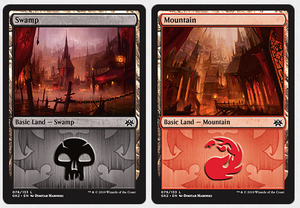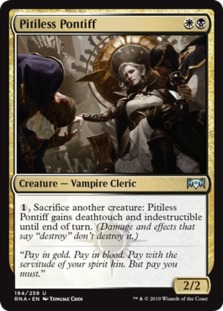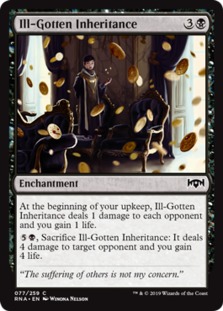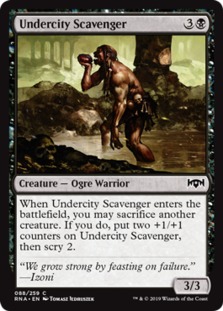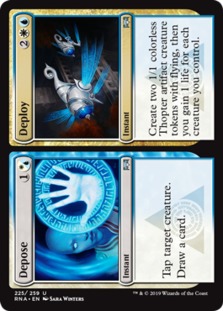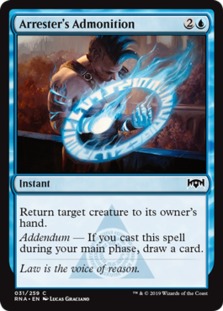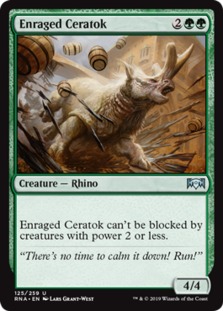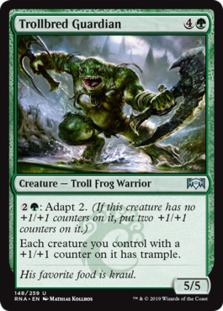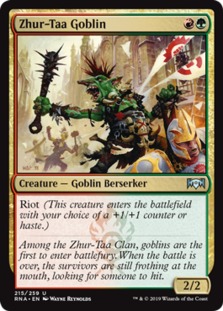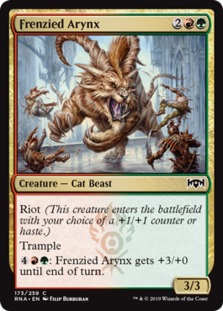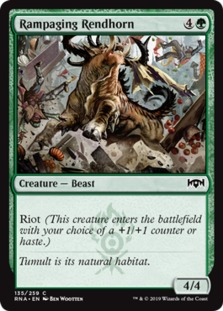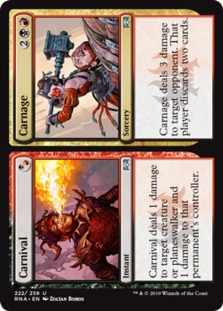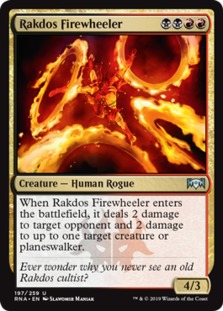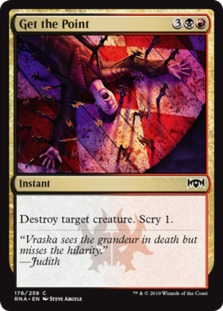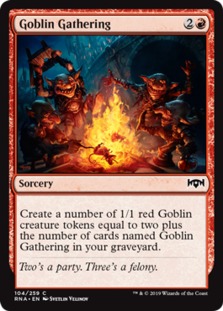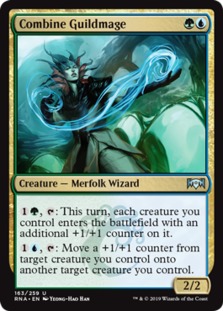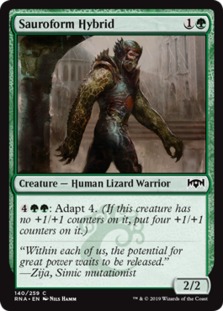Table of Contents
Once again on Arena we are forced to play an older format in Premier Draft. Luckily, we are getting an upgrade this time around. As far as the Ravnica formats go, Allegiance is much more dynamic and fun than Guilds. In this article I am looking to provide a framework for understanding the (11!) possible archetypes that can be drafted in Ravnica Allegiance, and will explain that number soon. I will also be identifying the strongest common and uncommon cards that support each archetype, and discussing some of the reasons why they work so well.
Event Details
Overview of Ravnica Allegiance
Typically I write an article when a new set comes out that breaks down all of the mechanics, card cycles, and archetypes. This time Wizards released an article that beat me to the punch and accomplishes this task really well. If you are new to Ravnica Allegiance I would definitely start there. It does an especially great job outlining the themes of each guild and going over the different types of cards that each guild gets a copy of (i.e. guildmages, XXYY uncommons, split cards, etc).
In my article I am looking to go more in depth with strategy, and help guide your Draft choices. I will give you my impressions of all of the two color guilds, and highlight key cards at uncommon and common within each guild. Further than that, I will explore some of the 3-color combinations in this format. Because each pack contains a gate land, 3-color decks are extremely viable in this set and can be outperform most 2-color combinations if the right synergies are present.
The Format and its Archetypes
Before diving into the archetypes, I want to make a few key observations about RNA:
- It is fairly Bomb heavy – some of your drafts are going to be guided by opening these.
- The creatures are Strong – this is good for midrange decks.
- Removal is fairly weak – this is a slight negative for control decks. There are a good number of removal spells in the format, but they tend to be overcosted or multicolor in comparison to other sets.
- The format is fairly slow – while there are a lot of very powerful 4-and-5 drop creatures, the low curve stuff is mostly below average. Explosive hands are possible but blowout Aggro decks are difficult to build in RNA, and it is generally better to go with a midrange strategy.
- There are many flyers – so every deck needs to have a plan for facing them.
There are five 2-color guilds in Ravnica Allegiance, and each has a new card mechanic associated with them. They are:
- Azorius (UW) – Mechanic: Addendum – Instant spells that gain a bonus effect when casted in the main phase.
- Gruul (GR) – Mechanic: Riot – Creatures can enter the battlefield with a +1/+1 counter or haste.
- Orzhov (BW) – Mechanic: Afterlife – Creatures generate 1/1 flying token(s) when they die.
- Rakdos (RB) – Mechanic: Spectacle – Spells become cheaper or add an effect if your opponent took damage that turn.
- Simic (UG) – Mechanic: Adapt – Creatures can buff themselves with +1/+1 counters, but only if they have no counters yet.
This brings me to the five 3-color combos. Yes, you can make more 3-color combinations but that would be unwise. The five combos I will be discussing draw from two guilds, making them much stronger than the others. It is important to understand these 3-color possibilities going into a draft since they can help you pick up good splashable cards and not waste picks on cards that are good but don’t get along with your current colors.
- Jund (RGB) – This combines Rakdos + Gruul (Red is the backbone)
- Temur (GUR) – This combines Simic + Gruul (Green is the backbone)
- Bant (WGU) – This combines Simic + Azorius (Blue is the backbone)
- Esper (UWB) – This combines Orzhov + Azorius (White is the backbone)
- Mardu (RWB) – This combines Orzhov + Rakdos (Black is the backbone)
So what is the 11th archetype?
Just like the 11th dimension that is necessitated in string theory, there is an 11th archetype in this format that needs to be mentioned:
- Gates, 4+ color ‘good stuff’ that is often referred to as Clear the Mind in reference to a card that allows you to recycle your deck in prolonged games. It is hard to pin down this archetype because it can lean into certain 2-color combinations depending on which powerful cards are available, but essentially you are playing all of the best cards you can find and rely on the mana fixing provided by gates.
This is a wild card archetype that can be arguably the most powerful in the entire format with the right payoff cards. This archetype works especially well when you are able to get multiple copies of three uncommons:
Gatebreaker Ram is the most important and is a good one to first pick. I like having a Gruul oriented gate deck when I find at least 4 combined copies of these three cards. Gateway Sneak and Archway Angel are decent tier 2 option to benefit from all of your gates. The ‘Clear the Mind’ deck tends to favor Esper colors, especially on Arena. Dovin’s Acuity is very important, and it tends to get passed by the bots. Also, Orzhov tends to be extremely open and having several copies of Grasping Thrull and Chillbringer is a great way to add a win condition with commons. Ultimately, having the ability to Draft all of the best Rares and Uncommons is what makes this archetype so scary to play against. The main weakness is its slow pace of play, often not dropping anything that affects the board in a substantial way until 4th turn. Ravnica Allegiance really doesn’t have many good Aggro options though, which helps explain why a durdly deck like this is able to be so successful in the format.
The Guilds of Ravnica… Allegiance
Now let’s take a deeper look into each of the guilds and the important cards for making them work. I will be pointing out some specific combinations, but as you go through each of them try to imagine how these cards could fit together to form 3+ color decks. Remember, this format encourages decks that draw from 3-or-more colors and they are quite viable considering the speed of the format and abundance of Gate lands. I will be going over each Guild roughly in order of their power level (in my opinion). I will start with the strongest and make my way down to the weakest. Keep in mind that this order is based on the previous times I have drafted the set when it has been in the Ranked Draft queue. It is entirely possible that the Arena bots will approach the cards differently this time around and shake up what is typically open. That didn’t really happen when Guilds of Ravnica was resurrected a couple weeks ago, but you never know.
Orzhov (BW)
In Limited, it is all about gaining little advantages, and getting a 1/1 flyer out of some of your creatures when they die is a fantastic way to do that. The primary flavor for a lot of Orzhov and Black cards in this set is sacrifice. Sacrifice is usually bad in Limited, because you are giving away card advantage when you do it. But, afterlife and sacrifice are very complimentary as utilizing them allows you to either sac something and get a 1/1 or sac the 1/1 that you’ve already gotten from before. So, you just need to make sure the supporting cards in your deck provide synergy with these mechanics. It doesn’t hurt that the Arena bots have historically passed many important Orzhov cards:
Powerful Uncommons
All of these cards are good, but rely quite a lot on synergy rather than being individually powerful. The only one that blows me away is Mortify, which I would definitely splash for. There are some very strong enchantments in this format that you would seriously consider blowing up over a creature. If I see mortify or a strong Orzhov rare early, I tend to look to add blue/Azorius cards and make an Esper flyers/control deck. I really love how well Esper can come together in Ravnica Allegiance. Ministrant of Obligation and Orzhov Enforcer would fit in great in that deck, helping to hold down the fort while you build up to your higher curve stuff. Bell Haunt can be tough to play on curve, but a 4-mana 3/4 that gains 3 life is still decent even you end up whiffing on the discard. Pontiff is solid in the right deck but often acts like a grizzly bear in the wrong one. Syndicate Guildmage is better than the Guilds of Ravnica ones, but is pretty average compared to the other Ravnica Allegiance options.
Important Commons
Grasping Thrull is the best common in these colors hands down. Final payment is a ‘sacrifice’ card that is well worth playing. It technically loses card advantage and might get a little clunky drawing two of them, but it is a good one-of in any Orzhov deck. I like that you can give up 5 life in a pinch or even an enchantment if the situation presents itself. Grotesque Demise is good in any deck playing black. Undercity Scavenger plays really well with the afterlife theme. 4 mana 5/5’s are always welcome, and scrying 2 is icing on the cake. Ill-Gotten Inheritance is a card that most people underrated initially in the set, but it is fantastic in a slower environment like this. It doesn’t belong in every deck, but suits grindy archetypes like this one really well.
Strategy
Orzhov doesn’t have flashy creatures, so expect long games with this deck. That is why Ill-Gotten Inheritance is great here. Orzhov is really good at trading cards and gaining small advantages. This can extend games as these advantages slowly add up. But, here’s the thing. If we add blue we gain access to a few key things:
- More flyers – Cards like Chillbringer can help add legitimate threats.
- Card Draw – Being able to gain some card advantage helps mitigate the sacrifice theme that often loses it,
- Control Spells – Orzhov already plays like a control deck so we might as well add blue and give it some traditional control spells.
So, rather than playing Orzhov alone I suggest getting some gates for an Esper Control mana base!
Azorius (UW)
Azorius is all about the flyers. As always, these colors support a control archetype, but with certain cards Azorius can seriously threaten opponents in the mid game. The mechanic Addendum rewards you for playing instant spells in your main phase. To take full advantage of this I think Azorius should be played as a midrange/tempo. But, it really depends on which cards you are able to draft:
Powerful Uncommons
Now here are some truly strong cards! I really like playing the High Alert deck. There are a lot of x/3 or x/4 flyers in blue and white, as well as cards like the 1/3 watchdog that become amazing once their toughness replaces their power. Spirit of the Spires becomes great in that deck as well. Generally the other 5 cards above are going to be better, though. Azorius Skyguard is my favorite card in these colors. The ability may not seem like much, but taking 1 power away from all of your opponents creatures is a really big deal. Angelic Exaltation is extremely powerful because it allows you to send forth a night-unstoppable creature and leave everything else back to block. Code of Constraint is a great cantrip spell and helps transform this archetype from control to tempo. The split card and guildmage for Azorius are probably the best among all of the guilds. If you are able to assemble several of these cards this guild is well worth playing, and is strong enough to not always need a third color to build a great deck.
Important Commons
Chillbringer and Lawmage’s Binding are both excellent cards that you will always be happy to play. Arrester’s Admonition is another cantrip spell that plays into the potential tempo theme. Azorius Knight-Arbiter is an absolute beast with High Alert in play (5/5 unblockable? yes please). He is no slouch by himself either since he can always block due to vigilance. Sphinx’s Insight is fantastic with Dovin’s Acuity (especially in the Clear the Mind deck). Senate Griffin is the least exciting of the bunch, but Snapping Drake with an ability serves just fine in filling out your creature slots.
Strategy
Pretty simple – protect yourself with high toughness creatures and peck at your opponent with evasive ones. The main downside is having creatures that are mostly low in power. Yes, High Alert fixes that problem but if you don’t draw it some games (and you won’t) you are at a pretty severe disadvantage. It is important to draft decks that aren’t overly reliant on certain cards. So, there are a couple options to consider. One, you can add black and create an Esper Control deck. Or, you can add green and create a Bant Midrange deck. Both of these decks can pull the best from Azorius while Esper gets additional control elements from black/Orzhov and Bant gets beefier creatures from green/Simic. Alternatively you can stick with just Azorius, but some inconsistency is to be expected, and can be very weak against 4-5 power creatures unless you are flush with Lawmage Bindings.
Gruul (GR)
Gruul decks can be very powerful and consistent with the right cards. The Arena bots seem to know this and have tended to overdraft it! Still, if this archetype seems even a little open I tend to go for it. In Gruul you need to have a lot of creatures (17ish) and prioritize removal spells, which can be tough to find sometimes in these colors.
Powerful Uncommons
The best cards here are Rhythm of the Wild and Trollbred Guardian, and they interact really nicely together.Sunder Shaman and Enraged Ceratok exemplify what this deck excels at putting out: very efficient creatures that are difficult to block. Burn and Fight spells, along with creatures like the guildmage or Clamor Shaman help remove additional blockers and keep the damage flowing. Keep in mind Rhythm stacks with creatures that already have riot, so it makes them all extremely mana efficient and hasty. The anti counter spell aspect is just icing on the cake.
Important Commons
Frenzied Arynx and Savage Smash are absolutely bonkers at common, and are a wonderful payoff for playing Gruul. Scorchmark is great at eliminating pesky afterlife creatures, while Skewer the Critics is a card you can never have enough copies of. Even without spectacle it clears the high curve creatures of most guilds (think chillbringer or grasping thrull), and having the flexibility of bolting your opponent as a finisher is just great. You’ll notice I included a lot of expensive creatures in this review. I like to round out my curve with 2-drops that can grow like Sauroform Hybrid and Gravel-Hide Goblin. These cards can score some damage early and are still relevant late.
Strategy
Draft a minimum of 16 creatures on a solid mana curve. Supplement them with cards that make them better (Rhythm of the Wild) or clear a path for them (Savage Smash/Scorchmark/Skewer). 1-2 combat tricks are okay but you never want to be in a situation where you can’t use them due to not drawing enough creatures. A deck like this drops threat after threat and efficiently deals with most obstacles your opponent might have. Some archetypes have flashier combos or bigger upside if certain cards are drawn, but this archetype is consistent, doesn’t need any rares (several good uncommons are necessary though), and follows the conventional wisdom of playing efficient creatures and removal to find victory in Limited.
Rakdos (RB)
Red/Black is and always will be an aggro deck. Rakdos gained a really great mechanic (spectacle) that helps propel the aggro strategy. With the right cards this deck can be incredible, but overall I don’t believe RNA is a good format for all out aggro decks.
Powerful Uncommons
There are a lot of great uncommons in Rakdos. I wanted to include two additional 4-drops here as well: Dagger Caster and Vindictive Vampire. Clamor Shaman is really great in an aggro theme, allowing you to continually attack and enable your spectacle cards. Cult Guildmage is another great spectacle enabler and the discard ability can be game changing against certain decks. He is probably the second best guildmage behind Senate (Azorius). Fireblade Artist gets in for early damage and then gives the deck some legs, allowing it to literally throw its creatures at the opponent after they establish blockers. Hackrobat is a creature your opponent doesn’t want to block, but punishes them if they don’t. Rakdos Firewheeler is probably my favorite XXYY uncommon of the set, not only because it is very good but I also think Red & Black should be played as a 2-color deck and not 3. I think adding Green or White to create a Jund or Mardu (respectively) 3-color archetype is generally wrong. This archetype is great at punishing more durdly decks as a clean 2-color deck that doesn’t require Gates. I have had the most success with Rakdos playing a low curve deck. There are quite a few ways to damage your opponent directly, which gives this thing some great reach as long as you are able to get in some early damage.
Important Commons
I’m not blown away at common in Rakdos, but there is some good stuff here. Grotesque Demise, Skewer the Critics, Get the Point, and Scorchmark are a good removal suite. Blade Juggler is a great spectacle card and I would always look for multiples. You definitely need to activate spectacle for cards like that, though, so creatures like Rakdos Roustabout are good filler that help ensure it. Rakdos Trumpeter is another card I could have included here that helps with spectacle due to its menace ability. Goblin Gathering does not belong in every deck, but if you can find a few copies and several ways to get extra value out of a bunch of 1/1’s it can be excellent!
Strategy
Low-Curve, 16 mana, and all out aggro is the way to go. If you try to incorporate too many high-cost spells your opponent will stabilize and you will run out of gas. This deck can really take people by surprise because it is mostly a slow format, so playing a deck with the ability to blitz can really punish some people’s drafts. It can be frustrating when you run out a bunch of small creatures and your opponent drops a 1/4 flyer or a 4/4 beast early on. This is a playable Guild but it makes me nervous at times because you really need to curve out for it to work.
Simic (UG)
This archetype is relatively straightforward, but i’ve had a really hard time getting it to come together properly. Adapt creatures are very good in this format, and there are several ways to get additional value out of the +1/+1 counters. There are some amazing cards in these colors, but while there looks to be a lot of synergy between them, it is often way to easy to disrupt Simic with removal.
Powerful Uncommons
The real stars here are Sharktocrab and Trollbred Guardian. Both of them are completely bonkers and if you get them early it is a great sign to draft this archetype. Keep in mind that Trollbred Guardian works really well in Gruul too with riot creatures, so just because he has adapt doesn’t mean you need to force Simic if you draft him. The other four cards here are pure Simic, though. Combine Guildmage is only okay on average, but if you draft some cards like Sharktocrab that can take advantage of his second ability, the value goes way up. Frilled Mystic is an interesting card. Not that I wouldn’t play it, but at higher ranks you will face opponents that will see your UUGG mana open and know what is happening. If your opponent has a board advantage where they don’t need to cast anything on their turn, it is better to play a spell rather than leaving mana open for Mystic. On the other hand, if you are ahead Frilled Mystic is a fantastic ‘win-more’ card. I probably wouldn’t reach for him if I am 3-color, but in Simic the mana cost is doable. Biogenic Upgrade can be a bomb for most board states. At minimum it gives you six +1/+1 counters for six mana. If you can hit things that have already adapted the value here is insane. Galloping Lizrog doesn’t belong in every Simic deck because it can end up putting all your eggs in one basket that then gets removed. However, it has great synergy with cards like Sharktocrab where you get a 5/5 trample for 5 and the ability to re-adapt Sharktocrab and tap down another creature the following turn.
Important Commons
The commons in the archetype leave some to be desired. Aeromunculus is the most important card here. After that, Chillbringer and Sauroform Hybrid are great choices. Skitter Eel is another solid adapt creature to pick. Because Simic doesn’t really have traditional removal, we are stuck tapping, bouncing, and fighting creatures. This can still be effective, but if there is any deck that I would run Quench in, it is this one. Sometimes it is a dud, but if my deck is really light on removal I am guilty of taking the gambit. You are often leaving mana open to adapt, so you usually don’t need to choose between Quench or playing a spell. Just realize that a lot of people will play around Quench if they can, and it is a dead draw late in the game.
Strategy
+1/+1 counters for everyone! You get a plus one counter! You get a plus one counter! But yeah, basically that is the archetype. This is a midrange tempo deck, but adding white gives it more of a control/flyers vibe, while adding red gives it some seriously powerful creatures.
Farewell For Now
The school where I teach may be closed down soon due to the virus, so I foresee quite a bit of Ravnica Allegiance in my future. Feel free to check out my twitch (http://www.twitch.tv/compulsion02) where I will be drafting some of these decks on my way back up to Mythic this season. Good luck to anyone competing with me in the Mythic Qualifier this weekend, and stay safe out there everybody.
Premium >
Enjoy our content? Wish to support our work? Join our Premium community, get access to exclusive content, remove all advertisements, and more!
- No ads: Browse the entire website ad-free, both display and video.
- Exclusive Content: Instant access to all exclusive articles only for Premium members, at your fingertips.
- Support: All your contributions get directly reinvested into the website to increase your viewing experience!
- Discord: Join our Discord server, claim your Premium role and gain access to exclusive channels where you can learn in real time!
- Special offer: For a limited time, use coupon code L95WR9JOWV to get 50% off the Annual plan!




























